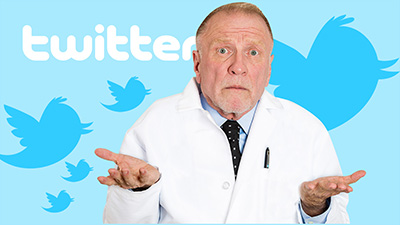Can You Say, “Dysfunctional Lens Syndrome?”
Can You Say, “Dysfunctional Lens Syndrome?”

Finally, along came the Visiometrics HD Analyzer. Last January, it showed that I had a great deal of “Ocular Scatter” and although I could be corrected to 20/25 with glasses, the test showed a simulated image of how my scatter was affecting my vision. My response was, “Yes! I’ve been telling you that is how I see, so will you now PLEASE take out my cataracts?”
In most practices, there is a long span of time between being diagnosed with presbyopia and the official pronouncement that the patient has a cataract. Patients know the quality of their vision is progressively declining. But because the doctor can’t always see or measure a qualified cataract, the patient is not given the option of fixing the problem and is forced to live with poor vision for many years. However, many Baby Boomers, like me, would much rather pay for better vision now and avoid waiting to have cataract surgery in the distant future.
Dysfunctional Lens Syndrome (DLS) is a great way to educate patients about lens change and the HD Analyzer is quickly becoming one of the most important diagnostic tools in helping refractive surgeons determine whether the best refractive procedure for any given patient should be a corneal approach or a lens approach.
Dr. George O. Waring IV commented that many of his patients who had LASIK years ago would come in complaining that their LASIK had worn off. “These patients would go on to have a clear lens extraction, however we knew these weren’t clear lenses,” he said. “The term Dysfunctional Lens Syndrome has greatly facilitated what used to be a challenging discussion prior to the characterization of this spectrum of the aging lens’s changes.”
Simply defined, DLS has three Stages: Stage I – 40s to 50s with Presbyopia; Stage II – 50s – 60s with decreased functional vision due to lens changes; and Stage III – cataracts as defined by Medicare. If a 50 year-old patient has a low OSI (Optical Scatter Index) the surgeon can explain Stage I DLS and how they would likely be a candidate for a corneal inlay or blended vision with LASIK. However, if a 45 year-old patient comes in for LASIK and has a relatively high OSI, the surgeon can explain Stage II DLS and that a corneal inlay or LASIK would not make them happy because, to quote Visiometrics motto, “Scatter Matters!”
What do you call a lens replacement procedure when the lens is cloudy but not a Stage III cataract? Dr. Mark Packer in a recent article in Ophthalmology Times said, “Refractive Lens Exchange means the primary purpose of the surgery is to reduce or eliminate the need for eyeglasses. Refractive Dysfunctional Lens Surgery means that the primary purpose of surgery is to improve functional vision impaired by lenticular aberrations and the secondary purpose of surgery is to reduce or eliminate the need for eyeglasses.” I vote for Dysfunctional Lens Replacement but definitely not Refractive Lens Exchange or Clear Lens Extraction (unless the sole complaint is wearing glasses or contacts).
Isn’t it time for eye doctors to stop telling patients that they do not have cataracts when indeed they do? DLS may not be a popular name at this time, but any patient at any age can understand the DLS concept, especially when they are shown the results of the HD Analyzer and how lens scatter affects their vision. With over half the US population being presbyopic and over 80 million Baby Boomers that don’t want to suffer through decades of declining vision, Dysfunctional Lens Replacement has the potential of becoming the procedure of choice for millions of patients in Stages I and II of DLS.



